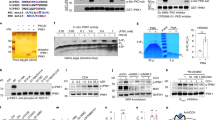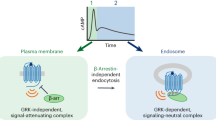Abstract
Exocytosis proceeds by either full fusion or 'kiss-and-run' between vesicle and plasma membrane. Switching between these two modes permits the cell to regulate the kinetics and amount of secretion. Here we show that ATP receptor activation reduces secretion downstream from cytosolic Ca2+ elevation in rat adrenal chromaffin cells. This reduction is mediated by activation of a pertussis toxin–sensitive Gi/o protein, leading to activation of Gβγ subunits, which promote the 'kiss-and-run' mode by reducing the total open time of the fusion pore during a vesicle fusion event. Furthermore, parallel activation of the muscarinic acetylcholine receptor removes the inhibitory effects of ATP on secretion. This is mediated by a Gq pathway through protein kinase C activation. The inhibitory effects of ATP and its reversal by protein kinase C activation are also shared by opioids and somatostatin. Thus, a variety of G protein pathways exist to modulate Ca2+-evoked secretion at specific steps in fusion pore formation.
This is a preview of subscription content, access via your institution
Access options
Subscribe to this journal
Receive 12 print issues and online access
$209.00 per year
only $17.42 per issue
Buy this article
- Purchase on Springer Link
- Instant access to full article PDF
Prices may be subject to local taxes which are calculated during checkout








Similar content being viewed by others
References
Ales, E. et al. High calcium concentrations shift the mode of exocytosis to the kiss-and-run mechanism. Nat. Cell Biol. 1, 40–44 (1999).
Alvarez de Toledo, G., Fernandez-Chacon, R. & Fernandez, J.M. Release of secretory products during transient vesicle fusion. Nature 363, 554–558 (1993).
Zhou, Z., Misler, S. & Chow, R.H. Rapid fluctuations in transmitter release from single vesicles in bovine adrenal chromaffin cells. Biophys. J. 70, 1543–1552 (1996).
Elhamdani, A., Palfrey, H.C. & Artalejo, C.R. Quantal size is dependent on stimulation frequency and calcium entry in calf chromaffin cells. Neuron 31, 819–830 (2001).
Wang, C.T. et al. Synaptotagmin modulation of fusion pore kinetics in regulated exocytosis of dense-core vesicles. Science 294, 1111–1115 (2001).
Miller, R.J. Presynaptic receptors. Annu. Rev. Pharmacol. Toxicol. 38, 201–227 (1998).
Wu, L.G. & Saggau, P. Presynaptic inhibition of elicited neurotransmitter release. Trends Neurosci. 20, 204–212 (1997).
Hamm, H.E. The many faces of G protein signaling. J. Biol. Chem. 273, 669–672 (1998).
Gillis, K.D., Mossner, R. & Neher, E. Protein kinase C enhances exocytosis from chromaffin cells by increasing the size of the readily releasable pool of secretory granules. Neuron 16, 1209–1220 (1996).
Stevens, C.F. & Sullivan, J.M. Regulation of the readily releasable vesicle pool by protein kinase C. Neuron 21, 885–893 (1998).
Sakaba, T. & Neher, E. Direct modulation of synaptic vesicle priming by GABA(B) receptor activation at a glutamatergic synapse. Nature 424, 775–778 (2003).
Chow, R.H., von Ruden, L. & Neher, E. Delay in vesicle fusion revealed by electrochemical monitoring of single secretory events in adrenal chromaffin cells. Nature 356, 60–63 (1992).
Zhou, Z. & Misler, S. Action potential-induced quantal secretion of catecholamines from rat adrenal chromaffin cells. J. Biol. Chem. 270, 3498–3505 (1995).
Artalejo, A.R. Electrical properties of adrenal chromaffin cells. in Electrophysiology of Neuroendocrine Cells (eds. Scherubl, H. & Hescheler, J.) 259–294 (CRC, Boca Raton, Florida, 1995).
Neely, A. & Lingle, C.J. Effects of muscarine on single rat adrenal chromaffin cells. J. Physiol. (Lond.) 453, 133–166 (1992).
Livett, B.G. & Boksa, P. Receptors and receptor modulation in cultured chromaffin cells. Can. J. Physiol. Pharmacol. 62, 467–476 (1984).
Ennion, S.J., Powell, A.D. & Seward, E.P. Identification of the P2Y(12) receptor in nucleotide inhibition of exocytosis from bovine chromaffin cells. Mol. Pharmacol. 66, 601–611 (2004).
Powell, A.D., Teschemacher, A.G. & Seward, E.P. P2Y purinoceptors inhibit exocytosis in adrenal chromaffin cells via modulation of voltage-operated calcium channels. J. Neurosci. 20, 606–616 (2000).
Augustine, G.J. & Neher, E. Calcium requirements for secretion in bovine chromaffin cells. J. Physiol. (Lond.) 450, 247–271 (1992).
Dodge, F.A., Jr . & Rahamimoff, R. Co-operative action a calcium ions in transmitter release at the neuromuscular junction. J. Physiol. (Lond.) 193, 419–432 (1967).
Holroyd, P., Lang, T., Wenzel, D., De Camilli, P. & Jahn, R. Imaging direct, dynamin-dependent recapture of fusing secretory granules on plasma membrane lawns from PC12 cells. Proc. Natl. Acad. Sci. USA 99, 16806–16811 (2002).
Graham, M.E., O'Callaghan, D.W., McMahon, H.T. & Burgoyne, R.D. Dynamin-dependent and dynamin-independent processes contribute to the regulation of single vesicle release kinetics and quantal size. Proc. Natl. Acad. Sci. USA 99, 7124–7129 (2002).
Wang, Y.T. & Linden, D.J. Expression of cerebellar long-term depression requires postsynaptic clathrin-mediated endocytosis. Neuron 25, 635–647 (2000).
Betz, A. et al. Munc13–1 is a presynaptic phorbol ester receptor that enhances neurotransmitter release. Neuron 21, 123–136 (1998).
Rhee, J.S. et al. Beta phorbol ester- and diacylglycerol-induced augmentation of transmitter release is mediated by Munc13s and not by PKCs. Cell 108, 121–133 (2002).
Nagy, G. et al. Protein kinase C-dependent phosphorylation of synaptosome-associated protein of 25 kDa at Ser187 potentiates vesicle recruitment. J. Neurosci. 22, 9278–9286 (2002).
Graham, M.E., Fisher, R.J. & Burgoyne, R.D. Measurement of exocytosis by amperometry in adrenal chromaffin cells: effects of clostridial neurotoxins and activation of protein kinase C on fusion pore kinetics. Biochimie 82, 469–479 (2000).
Currie, K.P. & Fox, A.P. ATP serves as a negative feedback inhibitor of voltage-gated Ca2+ channel currents in cultured bovine adrenal chromaffin cells. Neuron 16, 1027–1036 (1996).
Neves, S.R., Ram, P.T. & Iyengar, R. G protein pathways. Science 296, 1636–1639 (2002).
Blackmer, T. et al. G protein betagamma subunit-mediated presynaptic inhibition: regulation of exocytotic fusion downstream of Ca2+ entry. Science 292, 293–297 (2001).
Goubaeva, F. et al. Stimulation of cellular signaling and G protein subunit dissociation by G protein betagamma subunit-binding peptides. J. Biol. Chem. 278, 19634–19641 (2003).
Scott, J.K. et al. Evidence that a protein-protein interaction 'hot spot' on heterotrimeric G protein betagamma subunits is used for recognition of a subclass of effectors. EMBO J. 20, 767–776 (2001).
He, C. et al. Identification of critical residues controlling G protein-gated inwardly rectifying K(+) channel activity through interactions with the beta gamma subunits of G proteins. J. Biol. Chem. 277, 6088–6096 (2002).
Carabelli, V., Carra, I. & Carbone, E. Localized secretion of ATP and opioids revealed through single Ca2+ channel modulation in bovine chromaffin cells. Neuron 20, 1255–1268 (1998).
Lim, W., Kim, S.J., Yan, H.D. & Kim, J. Ca2+-channel-dependent and -independent inhibition of exocytosis by extracellular ATP in voltage-clamped rat adrenal chromaffin cells. Pflugers Arch. 435, 34–42 (1997).
Jarvis, S.E. & Zamponi, G.W. Interactions between presynaptic Ca2+ channels, cytoplasmic messengers and proteins of the synaptic vesicle release complex. Trends Pharmacol. Sci. 22, 519–525 (2001).
Smith, C. A persistent activity-dependent facilitation in chromaffin cells is caused by Ca2+ activation of protein kinase C. J. Neurosci. 19, 589–598 (1999).
Duan, K., Yu, X., Zhang, C. & Zhou, Z. Control of secretion by temporal patterns of action potentials in adrenal chromaffin cells. J. Neurosci. 23, 11235–11243 (2003).
Zhang, C. & Zhou, Z. Ca(2+)-independent but voltage-dependent secretion in mammalian dorsal root ganglion neurons. Nat. Neurosci. 5, 425–430 (2002).
Acknowledgements
We thank C. He for the Gβ1γ2 peptide, Y.T. Wang for the dynamin peptides and I. Bruce for reading the manuscript. This work was supported by grants from the National Basic Research Program of China (G2000077800 and 2006CB500800), the National Natural Science Foundation of China (30330210, 303328013 and C010505 to Z.Z.) and the US National Institutes of Health (DK46564 to C.L.).
Author information
Authors and Affiliations
Corresponding author
Ethics declarations
Competing interests
The authors declare no competing financial interests.
Supplementary information
Supplementary Fig. 1
Dose-response curve of ATP inhibition of quantal size. (PDF 203 kb)
Supplementary Fig. 2
PMA enhances Ca2+-dependent secretion by increasing the number of release events but not quantal size or amperometric spike kinetics. (PDF 484 kb)
Supplementary Fig. 3
PMA inhibits digitonin-induced quantal size in rat adrenal chromaffin cells. (PDF 443 kb)
Supplementary Fig. 4
2-MeS-ATP reduces quantal size of caffeine-induced amperometric spike but has no effect on the caffeine-induced [Ca2+]i signal. (PDF 539 kb)
Supplementary Fig. 5
ATP reduces both quantal size and amperometric spike numbers in depolarization-induced secretion. (PDF 663 kb)
Rights and permissions
About this article
Cite this article
Chen, XK., Wang, LC., Zhou, Y. et al. Activation of GPCRs modulates quantal size in chromaffin cells through Gβγ and PKC. Nat Neurosci 8, 1160–1168 (2005). https://doi.org/10.1038/nn1529
Received:
Accepted:
Published:
Issue Date:
DOI: https://doi.org/10.1038/nn1529
This article is cited by
-
Trace amine-associated receptor 1 regulation of Kv1.4 channels in trigeminal ganglion neurons contributes to nociceptive behaviors
The Journal of Headache and Pain (2023)
-
María Teresa Miras Portugal: a pioneer in the study of purinoceptors in chromaffin cells
Purinergic Signalling (2023)
-
Gβγ SNARE Interactions and Their Behavioral Effects
Neurochemical Research (2019)
-
Synaptotagmin-11 is a critical mediator of parkin-linked neurotoxicity and Parkinson’s disease-like pathology
Nature Communications (2018)
-
Arrestin-biased AT1R agonism induces acute catecholamine secretion through TRPC3 coupling
Nature Communications (2017)



